Content for TS 23.283 Word version: 19.1.0
1…
10…
10.2…
10.3…
10.3.2
10.3.3…
10.3.4…
10.3.5…
10.3.6…
10.3.7…
10.3.8…
10.4…
10.5…
10.6…
10.6.2…
10.6.3…
10.7…
10.8…
10.11…
10.12…
10.14…
10.15…
10.17…
10.6.2 Emergency calls
10.6.2.1 General
10.6.2.2 Emergency group call
10.6.2.3 In-progress emergency group state cancel of an interworking group
10.6.2.4 Losing audio
10.6.2.5 Default emergency group
10.6.2.6 Emergency private call
10.6.2.7 LMR systems that do not track group emergencies
...
...
10.6.2 Emergency calls p. 121
10.6.2.1 General p. 121
This subclause addresses various aspects of emergency call interworking.
Where the group is defined in the MCPTT system and where the IWF has affiliated to an MCPTT group with a single affiliation on behalf of all LMR group members, only a single IWF emergency group call request / IWF in-progress emergency group state cancel request message is sent to the IWF at the commencement / release of an emergency group call. Where the group is defined in the MCPTT system and where the IWF has passed through individual affiliations for each group member in the LMR system, the MCPTT system shall send individual IWF emergency group call request / IWF in-progress emergency group state cancel request messages to the IWF for all affiliated group members in the LMR system in accordance with primary and partner MCPTT system behaviour. In both cases, the distribution of the messages to group members in the LMR system is out of scope of the present document.
Where the group is defined in the LMR system, the IWF shall send individual IWF emergency group call request / IWF in-progress emergency group state cancel request messages to the IWF for all affiliated MCPTT group members in accordance with primary and partner MCPTT system behaviour.
10.6.2.2 Emergency group call p. 121
10.6.2.2.1 Emergency group call setup initiated by a user in the LMR system on an interworking group defined in the MCPTT system p. 121
Figure 10.6.2.2.1-1 shows the procedure for an emergency group call setup initiated by a user in the LMR system. The Figure is based upon the Figure for emergency calls in subclause 10.6.2.6.1.1 of TS 23.379. This scenario assumes that the group is an interworking group defined in the MCPTT system.
Pre-conditions:
- The MCPTT group is an interworking group defined in the MCPTT system
- MCPTT client 1 and MCPTT client 2 are affiliated to that MCPTT group.
- The IWF is connected to and is authorized to interwork with the MCPTT system.
- The mapping relationship of group and user identities between MCPTT system and LMR system has been configured at the IWF.
- LMR user initiates an emergency group call.

Step 1.
The IWF sends an IWF emergency group call request including a MCPTT group ID to the MCPTT server. The request contains an indication of the MCPTT emergency. The IWF may indicate in its request that an MCPTT emergency alert is to be sent when initiating an MCPTT emergency group call. The request may contain an indication of an implicit floor request.
Step 2.
The MCPTT server implicitly affiliates the MCPTT ID of the LMR user to the MCPTT emergency group if the user is not already affiliated. If the IWF is configured to affiliate on behalf of all of its group members in a single affiliation step, the MC service server affiliates the IWF instead of an individual MC service ID.
Step 3.
The MCPTT server checks whether the MCPTT ID of the LMR user is authorized for initiation of MCPTT emergency calls on the indicated MCPTT group. If authorized, it resolves the MCPTT group ID to determine the members of that MCPTT group and their affiliation status.
Step 4.
The MCPTT server configures the priority of the underlying bearers for all MCPTT participants in the MCPTT group. All successive calls during the MCPTT group's in-progress emergency state will receive the adjusted bearer priority.
Step 5.
The MCPTT server records the emergency state of the group. Once an MCPTT emergency call has been initiated, the MCPTT group is in an in-progress emergency state until that state is cancelled.
Step 6.
MCPTT server sends the MCPTT emergency group call request towards the MCPTT clients of each of those affiliated MCPTT group members as defined in TS 23.379.
Step 7.
If the group has other affiliated LMR users than the calling party and the MCPTT server has received individual affiliations from those LMR users, an individual IWF emergency group call request is sent (to the IWF) for each affiliated LMR user.
Step 8.
The IWF returns IWF emergency group call response(s) to the MCPTT server.
Step 9.
The MCPTT server sends the IWF emergency group call response to the IWF (as a response to the request received in step 1) to inform of the successful MCPTT emergency group call establishment.
Step 10.
The LMR users via the IWF and the affiliated MCPTTs have successfully established media plane for communication. The MCPTT system where the interworking group is defined is the controlling system of the group call.
10.6.2.2.2 Emergency group call setup initiated by a user in the MCPTT system on an interworking group defined in MCPTT system p. 123
Figure 10.6.2.2.2-1 shows the procedure for an emergency group call setup initiated by a user in the MCPTT system. The Figure is based upon the Figure for emergency group call in subclause 10.6.2.6.1.1 of TS 23.379. This scenario assumes that the MCPTT group is an interworking group defined in the MCPTT system.
Pre-conditions:
- The MCPTT group is an interworking group defined in the MCPTT system.
- MCPTT client 2 is affiliated to the MCPTT group.
- The IWF is connected to and is authorized to interwork with the MCPTT system.
- The mapping relationship of group and user identities between MCPTT system and LMR system has been configured at the IWF.
- The initiating MCPTT client 1 has been provisioned with the MCPTT group that has been designated via provisioning as the MCPTT emergency group.
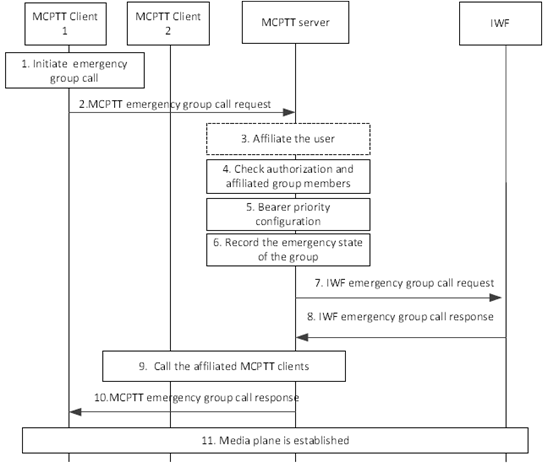
Step 1.
An MCPTT user initiates an emergency group call. MCPTT client 1 sets its MCPTT emergency state. The MCPTT emergency state is retained until explicitly cancelled.
Step 2.
The MCPTT client sends an MCPTT emergency group call request to the MCPTT server. The request contains an indication of the MCPTT emergency. The MCPTT client may indicate in its request that an MCPTT emergency alert is to be sent when initiating an MCPTT emergency group call. The request may contain an indication of an implicit floor request.
Step 3.
The MCPTT server implicitly affiliates MCPTT client 1 to the emergency group if the client is not already affiliated.
Step 4.
The MCPTT server checks whether the MCPTT user of the MCPTT client 1 is authorized for initiation of MCPTT emergency calls on the indicated interworking group. If authorized, it resolves the MCPTT group ID to determine the members of that MCPTT group and their affiliation status.
Step 5.
The MCPTT server configures the priority of the underlying bearers for all participants in the MCPTT group.
Step 6.
The MCPTT server records the in-progress emergency state of the group. The MCPTT server also records the identity of the MCPTT user that initiated the MCPTT emergency group call until the MCPTT emergency is cancelled. Once an MCPTT emergency group call has been initiated, the MCPTT group is considered to be in an in-progress emergency state until that state is cancelled.
Step 7.
The MCPTT server sends an IWF emergency group call request to IWF. If the IWF has affiliated to this group on behalf of the group's LMR users, only one IWF emergency group call request message is sent to the IWF. If the MCPTT server has received individual affiliations from the group's LMR users, an individual IWF emergency group call request is sent (to the IWF) for each affiliated LMR user.
Step 8.
IWF responds with the IWF emergency group call response(s) to MCPTT server to inform of the successful MCPTT emergency call establishment.
Step 9.
The MCPTT server sends the MCPTT emergency group call request towards the MCPTT clients of each of those affiliated MCPTT group members as defined in TS 23.379.
Step 10.
The MCPTT server sends an MCPTT emergency group call response to the MCPTT client to inform of the successful MCPTT emergency call establishment.
Step 11.
The LMR users via the IWF and the affiliated MCPTT clients have successfully established media plane for communication. The MCPTT system where the interworking group is defined is the controlling system of the group call.
10.6.2.2.3 Emergency group call setup initiated by a user in the LMR system on an interworking group defined in the LMR system p. 125
Figure 10.6.2.2.3-1 shows the procedure for an emergency group call setup initiated by a user in the LMR system. The Figure is based upon the Figure for emergency group call in subclause 10.6.2.6.1.1 of TS 23.379. This scenario assumes that the MCPTT group is an interworking group defined in the LMR system.
Pre-conditions:
- The MCPTT group is an interworking group defined in the LMR system.
- MCPTT client 1 and MCPTT client 2 are affiliated to that group.
- The IWF is connected to and is authorized to interwork with the MCPTT system.
- The mapping relationship of group and user identities between the MCPTT system and the LMR system has been configured at the IWF.
- LMR user initiates an emergency group call.
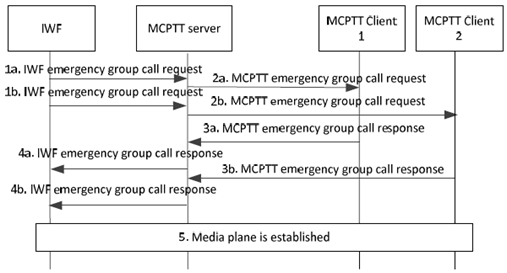
Step 1.
The IWF sends an IWF emergency group call request(s) to the MCPTT server. An emergency group call request is sent individually for each affiliated MCPTT user in the group. The request contains an indication of the MCPTT emergency.
Step 2.
The MCPTT server configures the priority of the underlying bearers and sends the MCPTT emergency group call request(s) as defined in TS 23.379.
Step 3.
The MCPTT clients respond with MCPTT emergency group call response to the MCPTT server.
Step 4.
The MCPTT server sends the IWF emergency group call response(s) to the IWF to inform of the successful MCPTT emergency call establishment.
Step 5.
The LMR users via the IWF and the affiliated MCPTT clients have successfully established media plane for communication. The LMR system where the interworking group is defined is the controlling system of the group call.
10.6.2.2.4 Emergency group call setup initiated by a user in the MCPTT system to an interworking group defined in the LMR system p. 126
Figure 10.6.2.2.4-1 shows the procedure for an emergency group call initiated by a user in the MCPTT system. The Figure is based upon the Figure for MCPTT emergency group call in subclause 10.6.2.6.1.1 of TS 23.379. This scenario assumes that the MCPTT group is an interworking group defined in the LMR system.
Pre-conditions:
- The MCPTT group is an interworking group defined in the LMR system.
- MCPTT client 2 is affiliated to the MCPTT group.
- The IWF is connected to and is authorized to interwork with the MCPTT system.
- The mapping relationship of group and user identities between the MCPTT system and the LMR system has been configured at the IWF.

Step 1.
An MCPTT user initiates an emergency group call.
Step 2.
The MCPTT client sends an MCPTT emergency group call request to the MCPTT server. The request contains an indication of the MCPTT emergency. The MCPTT client may indicate in its request that an MCPTT emergency alert is to be sent when initiating an MCPTT emergency group call. The request may contain an indication of an implicit floor request.
Step 3.
The MCPTT server configures the priority of the underlying bearer and sends an IWF emergency group call request to the IWF.
Step 4.
The IWF sends an individual IWF emergency group call request to the MCPTT server for each affiliated MCPTT group member, in this example to a user in MCPTT client 2.
Step 5.
The MCPTT server configures the priority of the underlying bearer and sends an MCPTT emergency group call request towards the MCPTT clients as defined in TS 23.379.
Step 6.
The MCPTT client responds with MCPTT emergency group call response, as defined in TS 23.379.
Step 7.
The MCPTT server responds to the IWF emergency group call request(s), received in step 4, with IWF emergency group call response(s).
Step 8.
The IWF sends an IWF emergency group call response to the MCPTT server, as a response to the request received in step 3, to inform of the successful MCPTT emergency group call establishment.
Step 9.
The MCPTT server sends MCPTT emergency group call response to the initiating user in MCPTT client 1.
Step 10.
The LMR users (via the IWF) and the affiliated MCPTT clients have successfully established media plane for communication. The LMR system where the interworking group is defined is the controlling system of the group call.
10.6.2.3 In-progress emergency group state cancel of an interworking group p. 128
10.6.2.3.1 LMR user initiated in-progress emergency group state cancel of an interworking group defined in the MCPTT system p. 128
Figure 10.6.2.3.1-1 shows the procedure for an in-progress emergency group state cancel initiated by an LMR user. The Figure is based upon the Figure for MCPTT in-progress emergency group state cancel in subclause 10.6.2.6.1.3 of TS 23.379.
Pre-conditions:
- The MCPTT group is in an in-progress emergency group state.
- The MCPTT group is an interworking group defined in the MCPTT system.
- The MCPTT client is affiliated to the MCPTT group.
- The IWF is connected to and is authorized to interwork with the MCPTT system.
- The mapping relationship of group and user identities between the MCPTT system and the LMR system has been configured at the IWF.
- An LMR user initiates in-progress emergency group state cancel of an interworking group.
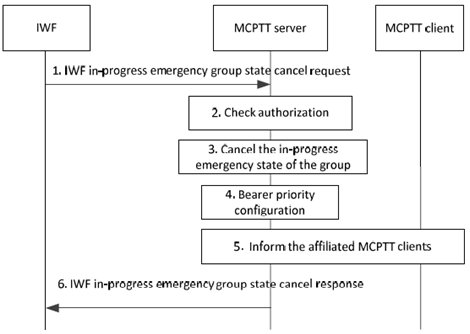
Step 1.
The IWF sends an IWF in-progress emergency group state cancel request to the MCPTT server. The IWF in-progress emergency group state cancel request may carry an indication that the emergency alert of the user is also being cancelled.
Step 2.
The MCPTT server checks that the initiator of the request is authorized to cancel the in-progress emergency group state of the group.
Step 3.
The MCPTT server cancels the in-progress emergency group state of the MCPTT group. If the emergency alert of the user is also requested to be cancelled, the MCPTT server cancels the emergency alert of the user.
Step 4.
The MCPTT server adjusts the priority of the underlying bearer; priority treatment is no longer required.
Step 5.
The MCPTT server handles the MCPTT in-progress emergency group state cancel request towards the affiliated MCPTT clients as defined in subclause 10.6.2.6.1.3 of TS 23.379.
Step 6.
The MCPTT server sends an IWF in-progress emergency group state cancel response to the IWF to confirm the IWF in-progress emergency group state cancel request.
10.6.2.3.2 MCPTT user initiated in-progress emergency group state cancel of an interworking group defined in the MCPTT system p. 129
Figure 10.6.2.3.2-1 shows the procedure for an in-progress emergency group state cancel initiated by an MCPTT user. The Figure is based upon the Figure for MCPTT in-progress emergency group state cancel in subclause 10.6.2.6.1.3 of TS 23.379.
Pre-conditions:
- MCPTT group is in an in-progress emergency group state.
- The MCPTT group is an interworking group defined in the MCPTT system.
- MCPTT client 2 is affiliated to that MCPTT group.
- The IWF is connected to and is authorized to interwork with the MCPTT system.
- The mapping relationship of group and user identities between the MCPTT system and the LMR system has been configured at the IWF.
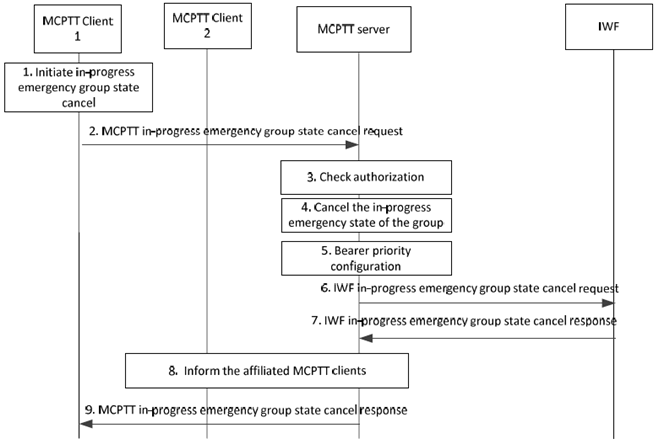
Step 1.
The MC user of MCPTT client 1 initiates in-progress emergency group state cancel of an interworking group.
Step 2.
The MCPTT client sends an MCPTT in-progress emergency group state cancel request to the MCPTT server. The request may carry an indication that the emergency alert of the user is also being cancelled.
Step 3.
The MCPTT server checks that the initiator of the request is authorised to cancel the in-progress emergency group state of the group.
Step 4.
The MCPTT server cancels the in-progress emergency group state of the MCPTT group. If the emergency alert of the user is also requested to be cancelled, the MCPTT server cancels the emergency alert of the user.
Step 5.
The MCPTT server adjusts the priority of the underlying bearer; priority treatment is no longer required.
Step 6.
The MCPTT server sends the IWF in-progress emergency group state cancel request to the IWF.
Step 7.
The IWF sends the IWF in-progress emergency group state cancel response to the MCPTT server to confirm the IWF in-progress emergency group state cancel request.
Step 8.
The MCPTT server handles the MCPTT in-progress emergency group state cancel request towards the affiliated MCPTT clients as defined in subclause 10.6.2.6.1.3 of TS 23.379.
Step 9.
The MCPTT server sends the MCPTT in-progress emergency group state cancel response to the MCPTT client 1 to confirm the MCPTT in-progress emergency group state cancel request.
10.6.2.3.3 LMR user initiated in-progress emergency group state cancel of an interworking group defined in an LMR system p. 130
Figure 10.6.2.3.3-1 shows the procedure for an in-progress emergency group state cancel initiated by an LMR user.
Pre-conditions:
- MCPTT group is in an in-progress emergency group state.
- The MCPTT group is an interworking group defined in the LMR system.
- The MCPTT client is affiliated to the MCPTT group.
- The IWF is connected to and is authorized to interwork with the MCPTT system.
- The mapping relationship of group and user identities between the MCPTT system and the LMR system has been configured at the IWF.
- An LMR user initiates in-progress emergency group state cancel of an interworking group.
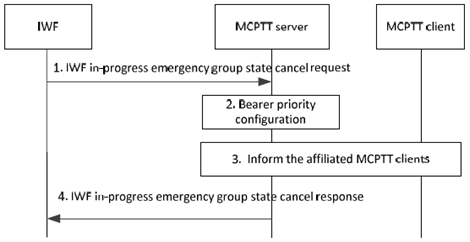
Step 1.
The IWF sends an IWF in-progress emergency group state cancel request to the MCPTT server.
Step 2.
The MCPTT server adjusts the priority of the underlying bearer; priority treatment is no longer required.
Step 3.
The MCPTT server handles the MCPTT in-progress emergency group state cancel request towards the affiliated MCPTT clients as defined in subclause 10.6.2.6.1.3 of TS 23.379.
Step 4.
The MCPTT server sends an IWF in-progress emergency group state cancel response to the IWF to confirm the IWF in-progress emergency group state cancel request.
10.6.2.3.4 MCPTT user initiated in-progress emergency group state cancel of an interworking group defined in an LMR system p. 131
Figure 10.6.2.3.4-1 shows the procedure for an in-progress emergency group state cancel initiated by an MCPTT user. The Figure is based upon the Figure for MCPTT in-progress emergency group state cancel in subclause 10.6.2.6.1.3 of TS 23.379.
Pre-conditions:
- MCPTT group is in an in-progress emergency group state.
- The MCPTT group is an interworking group defined in the LMR system.
- MCPTT client 2 is affiliated to that MCPTT group.
- The IWF is connected to and is authorized to interwork with the MCPTT system.
- The mapping relationship of group and user identities between the MCPTT system and the LMR system has been configured at the IWF.
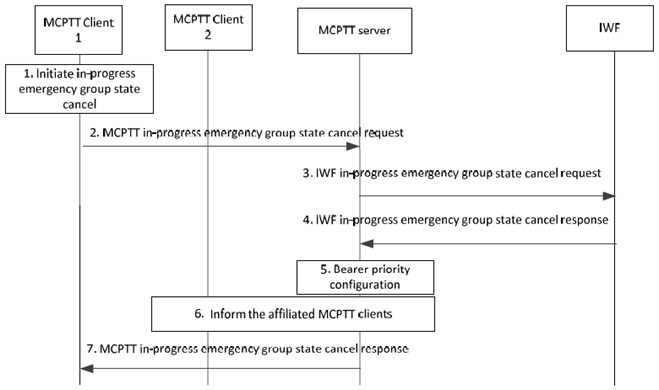
Step 1.
The MC user of MCPTT client 1 initiates in-progress emergency group state cancel of an interworking group.
Step 2.
An MCPTT client sends an MCPTT in-progress emergency group state cancel request to the MCPTT server. The request may carry an indication that the emergency alert of the user is also being cancelled.
Step 3.
The MCPTT server sends the IWF in-progress emergency group state cancel request to the IWF.
Step 4.
The IWF sends the IWF in-progress emergency group state cancel response to the MCPTT server to confirm the IWF in-progress emergency group state cancel request.
Step 5.
The MCPTT server adjusts the priority of the underlying bearer; priority treatment is no longer required.
Step 6.
The MCPTT server handles the MCPTT in-progress emergency group state cancel request towards the affiliated MCPTT clients as defined in subclause 10.6.2.6.1.3 of TS 23.379.
Step 7.
The MCPTT server sends the MCPTT in-progress emergency group state cancel response to the MCPTT client 1 to confirm the MCPTT in-progress emergency group state cancel request.
10.6.2.4 Losing audio p. 133
For LMR systems where a user cannot be pre-empted, the IWF identifies the audio as losing audio to the system. Subclause 10.5 is applicable to losing audio during emergency calls as well as non-emergency calls.
10.6.2.5 Default emergency group p. 133
In MCPTT, the user's profile determines whether an emergency is raised on the user's currently selected group or on a configured default emergency group. It's up to the IWF and the LMR system to which it is connected to determine what group the emergency is raised on and whether an alert is also sent when the emergency is raised. From the perspective of the MCPTT system, all emergency behavior by the IWF on behalf of its users mapped to MCPTT shall comply with behaviors defined in TS 23.379. The implementation shall ensure that emergency related parameters of a group or private call are adhered to. For example, an MC service group must be configured in the MC sevice group managment system for emergency alerts in order for an emergency alert to be sent on it. This can be enforced through proper configuration of both LMR and MCPTT systems or can be enforced at run time by the IWF.
10.6.2.6 Emergency private call p. 133
An emergency private call to an LMR user will have emergency priority for the portion of the call transported in the MCPTT system and the LTE EPS but will not receive priority on the LMR system in LMR systems that do not support emergency treatment for private calls.
10.6.2.7 LMR systems that do not track group emergencies p. 133
The MCPTT system tracks the emergency state of every group. In interworked LMR systems that do not track the emergency state of groups, only a UE in emergency state will be given emergency priority on the LMR system when talking. For any user talking on an emergency group, the portion of the call transported by the MCPTT system will receive emergency priority.